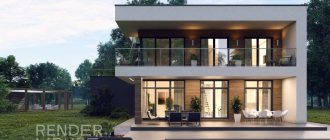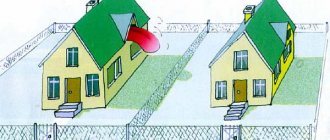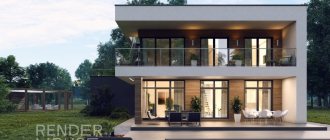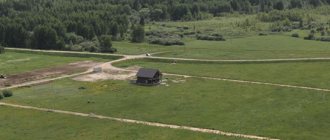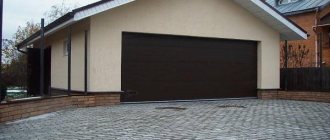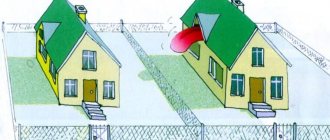The layout of residential development and the placement of ancillary buildings on the territory are determined by construction standards and rules. Many car owners believe that on plots near private houses they can build a garage structure anywhere. This is wrong. To erect permanent buildings on land for individual housing construction and personal subsidiary plots, it is sometimes necessary to obtain permission. It is necessary to comply with the regulations for the construction of a garage on the site.
Do you need documents to build a car garage?
If the car owner intends to use the garage only for personal purposes, there is no need to apply to the local administration for permission. Regulated by Art. 51 of the Town Planning Code of the Russian Federation.
If the arrangement of a garage structure is intended for doing business, contact the town planning department of the local municipality with an application. Specialists will visit the site to determine whether construction work can be carried out. The landowner must present:
- Title documents for land.
- General plan of the building.
- Relief plan.
- Scheme of engineering networks.
When a garage box is built on your own land for personal use, fire and sanitary requirements are strictly followed.
What to do if you need to reduce the distance from the garage to the wooden building
According to SNiP requirements, the gap from a permanent wooden house to a garage should be 15 meters. You can maintain 6 m if the following requirements are met:
- build and equip a fire shield, placing it near the garage;
In some cases, a more practical solution would be a mobile fire shield on wheels Source plamyanet.ru
- keep the fire extinguisher separately in the garage itself;
- arrange the electrical cable in accordance with PTEEP;
- do not equip the garage with a heating system;
- wrap all electrical cables in a metal sleeve;
- install fuses on the meter;
- protect lighting fixtures with shades;
- conduct the electrical wiring so that it passes through the meter located in the house.
Some subtleties of the issue
Is it possible to build a car garage on an area bordering a road?
The requirements should not be violated. A car garage built on the border with the roadway may cause disputes from neighbors. They can prove that the structure would prevent a fire truck from turning around to approach them. The court will order the dismantling of such a building.
This is interesting: 3 meters indentation from the border of the site
Possibility of erecting a box on the border with the alley
According to the Code of Rules 42.13330.2011, any auxiliary outbuilding (including a car garage) located in the local area must be located from the border of the site, maintaining a distance of 1 meter. The joint venture allows outbuildings on neighboring territory only with the consent of the neighbors. Otherwise, the court will make a decision to demolish the building if the owner does not move it 1 meter from the border of the UZ.
If the owner of a nearby house has violated the requirement, they file a statement with the fire department outlining their claims. Be sure to make a reference to the Federal Law “Technical Regulations on Fire Safety Requirements” No. 123 of July 22, 2008.
What to do if your neighbor's garage has encroached on your property
Many people face the problem when a neighbor's garage is partially located on their land. This happens when buying real estate. If the owner has completed all the documents for the purchased house and plot and is confirmed by an extract from the Unified State Register, he has the right to demand that his neighbor dismantle the garage box on a voluntary basis. If the owner of the neighboring territory does not remove the structure within the specified period after receiving a written notice, they file a claim in court.
In Russia, documents have been adopted regulating the correct development of plots that are privately owned by citizens. If you strictly follow all legal standards when building a garage on a plot of land, you will not have any troubles with the authorities and neighbors due to improper placement of the facility. Building codes and regulations are regularly updated and supplemented with new construction techniques. They need to be studied before carrying out work.
Is it possible to build a garage on the border of the plot?
Often in old houses you can find this arrangement. Moreover, garages can also be double, when neighbors decide to build a joint building on the boundary dividing line. This is a good option that “works” only in the case of cloudless relations between neighbors, as well as a joint distribution of responsibilities for maintaining the structure.
Technically, this arrangement is possible, but there are some nuances. First of all, this is the written consent of the second party about the location of the building on “common” land. Even if it is received, do not forget about the possibility of force majeure.
“Pitfalls” of this option:
- The neighbors' written consent must be renewed every three years. After this period it is considered invalid.
- When the owner of the neighboring plot changes, the contract is automatically canceled, and it is still unknown whether the new owner will agree to such a decision.
- The heirs or even the significant other of the owner of the neighboring plot also have the right to terminate such an agreement.
- Structural changes to the architecture of the garage must also be agreed upon with the owner of the neighboring property.
As you can see, the location of the garage on the border of the site is fraught with troubles. In addition to legislative rules, there is a risk of being drawn into proceedings simply because relations between neighbors have deteriorated or any modernization of the premises will become impossible.
At what distance from the fence can a garage be built: SNiP norm and law
When placing a permanent garage for your favorite car on the site, you need to take into account existing standards. To exclude claims from government agencies and neighbors, you should know at what distance from the fence you can build a garage. It is necessary to determine in advance the list of permits and the procedure for constructing buildings of this type. This will help to avoid complaints and problems upon completion of the construction of a garage next to the fence due to non-compliance with distance standards, rules and legal requirements.
Regulatory restrictions
The construction of main and auxiliary buildings must be carried out without violating building codes and regulations (hereinafter referred to as SNiP), which take into account technical, legal and economic requirements in relation to architectural surveys and urban planning.
In order to be able to register a new building as an object of real estate owned, it is necessary to obtain the appropriate permission.
An exception is represented by a combination of the following circumstances:
- Construction of a garage is not associated with the desire to make a profit from rental activities, vehicle repairs and other things.
- They plan to install the box on land owned by the owner, allocated for housing construction or non-profit gardening activities (SNT or dacha cooperative).
- The box does not have a foundation, for example, a metal one, therefore, it does not belong to capital construction projects.
In all other cases, the owner of the site is obliged to contact the architectural department of local authorities, submitting the following documents:
- a written statement with mandatory information (from whom, to whom, circumstances and essence of the request);
- a copy of the identity document of the owner of the land plot;
- document confirming land ownership;
- topographic reference to the area;
- cadastral plan of house construction and adjacent territory;
- technical documentation with BTI assessment information;
- scheme for entering communications into the housing construction area;
- project.
Having received the application, the official is obliged to issue a receipt to the applicant stating that the documents have been accepted for consideration. The decision on whether it is possible to build a garage in the declared location is made within ten working days. In practice, this procedure takes longer.
If a negative decision is received, all documents must be returned. The applicant has the right to re-submit a petition to the same body after changing the construction plan or may appeal to the courts to appeal an administrative, in the opinion of the applicant, unlawful refusal.
How to legitimize
Russians often build garages without any prior permits or completed design documentation. Such an object is considered illegal.
However, there is a way to legalize a building erected without permits and technical documentation. To do this, it is necessary to retroactively carry out all the actions that usually precede construction. Design documentation should be ordered. Get it approved by the local government administration. Obtain permission to put the facility into operation. Afterwards, the garage structure is registered in the cadastral register and registered with Rosreestr.
Unauthorized construction
An unauthorized construction can be legalized if it is erected on legally allocated land. Usually the plot is given for individual housing construction, construction of a summer house or for gardening. A garage built on such an area can be considered a commercial building. A garage structure can be easily legitimized if it was built on a land area specially allocated for garage construction.
When there are no rights to land, it is problematic to legitimize self-storage. However, in this case, you can find a way out. When legitimizing an unauthorized construction, all actions are carried out retroactively. The garage should actually be listed as not yet built. It is not recommended to inform the authorities about the current situation. Otherwise, the squatter building will be required to be demolished, and the citizen will be fined.
If a person had legal grounds for construction, but is not given permission, he can go to court. To resolve your issue positively, you must present documents about the expenses incurred and permission to use the site.
With an illegal object, the situation is somewhat different: it is possible to legitimize an unauthorized construction if you write an application to the local municipality. You can apply to leave the unauthorized building and transfer it to another status.
In a co-op
At GSK, all design and estimate documentation is developed by the department before construction begins. Typically, the land area for a garage complex is allocated by order of the local government. Obtaining permits for the building and land plot is the responsibility of the GSK management.
The manager must enter into a land lease agreement with the local government and obtain permission to build the entire complex. It will not be possible to legitimize a single box in a linear structure. You must first arrange to obtain ownership of the entire property and land. Then each shareholder receives his share.
On your own plot of land
You can build an object on your own plot, based on the purposes for which the land area was allocated. If the plot of land was taken for individual housing construction or the construction of a summer house, then first the main object is erected, and then auxiliary buildings, for example, a parking lot. If the land area was allocated only for the construction of a garage structure, you need to contact the state administration and obtain permission to build the facility.
If the site was allocated for the construction of commercial real estate, then it will not be possible to additionally legalize the garage.
In the courtyard of an apartment building
It is impossible to build a permanent garage structure in the yard, near an apartment building. Unless a citizen inherited land in this place or registered ownership of it. This can be done if the local government has issued an order to change the designated purpose of the local area.
Typically, such an area is intended only for servicing a residential building and satisfying the household, housing and social needs of its residents.
Removal from objects
Obtaining a building permit largely depends on compliance with SNiP requirements in the construction project, in particular, whether the minimum permitted distances to courtyard buildings, neighboring houses and infrastructure facilities are observed during the construction of a garage.
SNiP norms for 1997 prescribe the following for outbuildings, which include car premises:
- distance from residential buildings if the garage is attached - 3 m;
- distance to other outbuildings (barn, separate attic, etc.) from 1 m;
- distance from the fence to the garage from 1 m;
- the sector to the bush is at least 1 m;
- distance from trees of moderate growth from 2 m;
- the distance between the extension and tall trees is from 4 m;
- the distance to the neighbor’s residential building is at least 6 m;
- to the “red line” (the border of private households and municipal land) more than 5 m.
A garage cannot be built close to a fence. It is necessary to make 1 meter indentations from the neighbors' fence.
Restrictions on the specific placement of the car box and the functioning of its individual structural elements:
- If the garage is attached to the house, then the distance to the nearest building should be at least 3 m.
- When placing the box with the gate facing the street, a distance of 3 meters from the road must be maintained.
- The distance from the garage to the roadway in villages and cities is at least 5 m, while the distance is calculated from the base of the building or roof if its protrusion exceeds 0.5 m.
- If one of the sides is adjacent not to the neighbor’s fence, but to an alley, then the distance to the road should be less than 3 m.
- Installation closer than two meters to a power line support is not allowed.
Violation of SNiP regulations in the event of unauthorized construction is not grounds for initiating administrative or criminal proceedings. But the initiation of a complaint by a neighbor or an investigation into the consequences of an emergency due to the fault of an attached building will lead to the court making a decision precisely in accordance with SNiP.
Red line
The previously mentioned property line designation of land is an important factor in determining the feasibility of construction in the selected location.
As a rule, on state territory near private houses there are lighting poles, information signs, etc.
Main gas supply lines, water supply and drainage communications are hidden underground. They are combined with pedestrian paths, and in many cases, highways and local roads.
Construction restrictions make it possible to ensure unhindered 24-hour access to life support lines for the population. The master plan (GPZU) of any settlement contains the exact location of the red lines. If in the documentation submitted for approval the distance from it to the box is less than 5 m, then a negative answer will most likely be received.
There is a high probability that if the construction of a building was carried out without taking into account the distance to the red line, the owner will be forced to demolish it by court decision.
What nuances should you pay attention to?
When building a garage, the following aspects must be taken into account:
- The distance to the closest building must be at least 3 meters if the garage is attached to a residential building.
- The normal distance to the road is 3 meters if the garage door opens towards the street.
- The distance is at least 5 meters if the garage is built close to the garage building.
- If one of the walls of the garage adjoins the street, the distance should be 3 meters or more.
- If there is a power line nearby, the permitted distance is 2 meters or more.
As for the distances from a summer cottage or a plot with a neighbor’s private house, they are shown in this figure.
If a garage is built without permission, and in violation of legal norms, then this fact in itself does not give the right to initiate a case. However, in the event of complaints from residents, an emergency or other negative outcomes, then the norms will become a guideline for decision-making by the court.
Therefore, in order to prevent unpleasant situations, you must follow these rules yourself.
Features of the neighborhood with wooden buildings
The proximity to a farmstead where a wooden residential building is built increases the mandatory distance to 15 m. At the same time, the right to agree with the owner on reducing this distance is retained. Consent is drawn up in writing and certified by a notary.
The same procedure for neighbors to resolve the issue applies to brick buildings, if it is necessary to build a room for a car at a distance of less than 6 m. A prerequisite for receiving a positive answer from a neighbor is to ensure sufficient fire safety measures.
This is interesting: What to do if a plot of land crosses the border of a municipal entity
To do this you need:
- install an external shield with recommended fire-fighting accessories;
- place a fire extinguisher in the room;
- ensure that the room is not heated;
- place the electrical power supply distribution panel outside the building;
- equip the electrical panel with an automatic load switch;
- trace the wires in a protective metal sleeve;
- equip lighting devices with factory shades.
If the above recommendations are not followed, you may not only lose the opportunity to resolve the issue peacefully, but also aggravate the situation as a whole. Thus, guided by Article 304 of the Civil Code of the Russian Federation, the owner of a neighboring plot may demand that construction and operation be brought into compliance with fire regulations. Failure to comply with the permitted construction distances is a direct possibility of fire spreading.
Construction documents
The flexible system of legislation does not regulate exactly what must be provided before building your own garage. The best option is to find an intelligent architect associated with this field. Regulations may change even depending on the region of residence, so it is impossible to provide exact advice and instructions.
The following points can be highlighted:
- The construction of a garage on the site of an old structure already included in the technical passport does not require registration again.
- Modernization and any design changes must be agreed upon and also secured at the legislative level.
- The construction of a new residential and utility structure, as well as the installation of fences, requires familiarization of all neighbors and their written consent with your plan. If someone disagrees, this opinion must also be taken into account.
- Controversial issues regarding the placement of boundary boundaries and corresponding buildings must be resolved with the involvement of geodetic services.
- The simplest, but most expensive way is to order the layout of structures from an independent architectural organization. Of course, this will help solve many problems, but the cost of such services will be very significant.
- If construction work is underway on your property and on your neighbor’s property at the same time, it is important to agree on the location of the new facilities with the owner of the neighboring property. It would be a good idea to consolidate such agreements in a written agreement so that problematic issues can be challenged in the future.
This is probably the most difficult part of the future garage construction project. Often such litigation drags on for a long time, especially when it comes to controversial issues between the owners of neighboring plots. In this case, our advice can help, as well as compliance with basic standards for the placement of outbuildings on the site.
Recommendations for choosing a site for construction
In order to have fewer questions when coordinating documentation with the architects of the local administration, the construction of a capital box should be planned taking into account the following:
- If the building is located inside a courtyard area, then the entry of a car should not be accompanied by additional maneuvers.
- There should be enough space on the inside of the entrance gate to lock the garage door.
- The entrance to the garage, if it is adjacent to the street, must be designed to provide sufficient visibility for the safe maneuver of exiting vehicles.
- Opening the gate should not interfere with the movement of pedestrians and passing cars.
- The building should not block the access of light to the neighbor’s vegetable garden or garden if it contains low-growing varieties of trees.
- Water drainage from the roof must be directed to the territory of your site, both from the roof and along the ground using a ditch.
- Planting your own trees is carried out taking into account the requirements of SNiP.
- If you decide to build a garage adjacent to the house or allocate a basement floor for it, then all fire safety standards must be met. They relate to the equipment of the room with a hood, fire equipment, and a fire alarm.
If the garage is located in a private house in the basement, then fire safety rules allow parking and storage of vehicles running on liquid fuel there.
About garage sizes
At the design stage, the internal dimensions of the garage should be provided to ensure minimal comfortable and safe use. They can be:
- on both sides of the car - 0.8 m;
- if there are columns - at least 0.6 m;
- from the trunk and hood of the car - at least 0.7 m;
- with impressive parking dimensions, when parking cars one after another - 0.6 m;
- if parallel parking of two cars is provided, then a width of 1.6 m and a length of 1.4 m are added to the standard dimensions.
About the ceiling height. In accordance with SNiP standards, the ceiling height is taken to be the distance from the surface of the floor covering to the maximum protruding lighting fixture or communication element. The safety gap to the car cannot be less than 0.2 m.
Following the recommendations will not only help you comfortably use the room for its intended purpose, but also in a critical situation.
For example, in the event of a fire, this will allow the evacuation of vehicles and stop the spread of fire.
Detached garage
The most popular and traditional option is that the garage is separate from the residential building. It can combine additional functions: a basement, a workshop or utility rooms for storing tools. If this is your case, do not ignore some important aspects of placement on the site.
Basic moments:
- To erect a building, it is advisable to use the northern side, an unused plot, or simply a plot of land that is optimal in location.
- When combining a garage with other outbuildings, it is necessary to consider two separate entrances that do not communicate with each other. To do everything in accordance with the letter of the law, the distance between entrances must be at least seven meters.
- To build a garage, you must choose a site on an elevation (natural or specially created). This will protect the building from flooding and help make a suitable entrance.
- Melt water should only be drained onto your own site. If the canopy of a building exceeds half a meter, the distance to the adjacent fence is measured from its projection.
- If there is already any structure on the neighbor’s property, the location of the garage must be at least five meters away from it. How you can reduce this distance is described a little further.
Is it possible to build a garage on the boundary line? This issue is discussed in detail in further information. If we are talking about a permanent structure, be sure to make such changes to the official site plan. This will save you from many bureaucratic problems in the future and will allow you to feel confident in any situation. You should also not ignore maintaining the required meter between the fence and the building. Even without taking into account possible problems with neighbors, this distance will help in the trouble-free operation and maintenance of the building, for example, when performing external insulation or painting.
Litigation
Clarification of relations between neighbors in the courts is an extreme measure used in cases where it is impossible to find mutual understanding. But if it is not possible to dispose of your land to build a garage due to unfounded claims, then there are no other ways to prove your case.
To consider the case in court, the plaintiff prepares and submits a statement of claim accompanied by title documents of a housing nature. Their list duplicates the necessary papers for approval of the project by the administration architects.
The plaintiff also sets out the circumstances and subject of the illegal claims, methods and means of preventing the realization of rights. The statement of claim is supplemented with evidence in the case in the form of photographs and video materials.
Before preparing a statement of claim, you should make sure that there are no violations on the part of the plaintiff, and that the norms for distances from residential and auxiliary premises are met. Otherwise, it will not be possible to count on a positive decision.
How much do you need to step back from the fence when building a garage?
Similar situations often arise that have simple solutions, including:
- The owner built a garage close to the fence, he doesn’t know what to do. The only correct decision is to fulfill all fire safety training requirements and come to an agreement with the neighbor, documenting the absence of objections.
- What distance should you retreat from the fence when building a garage if the red line is 9 meters away? With such a distance from the property line of the land, the minimum distance between the garage and the fence must, by law, be at least 1 meter.
- If a neighbor built a garage from the fence, without retreating, violating the 1 meter standard, and the side wall is located close to the fence, what should you do? If construction took place without approval, then you need to file an application with the court.
- How much should you step back from your neighbor's house if it is wooden and there is no fence around the property? You should focus on the recommended standards - 15 meters. You can install an iron or brick garage after agreement with your neighbor.
- Settlement in the household after its acquisition occurred later than the time the neighbor built the garage; it turned out that the distances were maintained, and the light did not enter the yard. The courtyard is not a vegetable or garden area. Distances have been maintained, and there is nothing to file claims in court for. In this case, all that remains is to redevelop your site as much as possible.
Every year the country's legislation is improved, and SNiP requirements undergo changes. In this regard, to obtain objective information in each specific case, you should seek advice from practicing specialists. This also applies if difficulties arise when independently preparing a project for a future garage.
How many meters to retreat when erecting an individual building on a site is shown in the video below.
Building regulations
The standards for indentations during the construction of garages depend on several significant circumstances, which can be determined by studying the relevant SNiP. The garage, according to the current legislation of 2021, belongs to outbuildings. Therefore, official permission for its construction is not required. But this applies only to collapsible options, without a foundation.
Not far from neighbors house
The garage must be present on the plot plan because codes and regulations define distances differently. They must be observed in relation to the fence and buildings of the neighboring area. In this case, an indentation from the red line is necessary.
The garage attached to the house has its own characteristics and nuances. When using the rear wall of a building instead of a fence along the property line, compliance is taken into account.
Garage construction standards apply only to buildings on a foundation. But the distance from the foundation is taken into account only if the auxiliary building does not have a canopy or gutter for drainage. Then the required distance is measured from the projection of the protruding part onto the ground.
Setbacks from the boundary of the neighboring plot and the road according to SNiP standards
The absence of the need to obtain permission to build an easily dismantled structure does not mean that the setback dimensions do not need to be observed. Such a neglectful attitude can cause discontent on neighboring landowners, and then complaints to the authorities or lawsuits cannot be avoided.
Basic fire safety requirements for garages
It’s good when the site is large and convenient. Review the projects, choose the one you need and place buildings, gardens, and yard according to your taste. It is more difficult to equip a small and not very convenient area. It does not matter whether a summer house or a house for permanent residence will be built, such buildings as a barn, garage, summer kitchen, gazebo are always desirable and necessary on private property.
This is interesting: Boundaries of buildings on a plot of land
Monolithic brick fence combined with a garage
A rational approach to site planning allows you to save space and significantly reduce the cost of landscaping. One of the options for saving space is projects of fences combined with a garage. This method of placing a building has its advantages and disadvantages, its fans and opponents.
The advantages of joint construction include:
To create a single yard style, a garage and a fence with common boundaries must be made of the same material, in a common style.
Projects for the joint construction of a fence and a garage have an option when a common wall with a gate facing directly onto the street becomes common. In this case, the garage door and the gate are made of the same materials, the same color and design.
The second option is a common side wall, and the garage door is located at some distance from the fence gate. In this case, the costs of building two gates are added, but it is possible to park the car in the yard without a garage.
The garage fits best into a fence made of brick or stone; in this case, they create a single picture. Finishing of both the common wall and the rest is carried out with the same materials. A rich look is created by gates with forging elements.
Another excellent material for this type of placement of buildings is corrugated sheeting. Fences made from it have already become firmly established, and garage designs made from corrugated sheets are an innovation, but quickly adopted by car enthusiasts.
This is the simplest material for building both a garage and a fence on your own, and is also affordable.
Instead of a garage - a canopy to the fence
A common wall makes it possible not to build a permanent structure, but to attach a covered canopy to a high fence. Building a carport is advisable if you have several cars and it is not possible to build a large garage.
Option for a canopy to the fence instead of a garage
Covered parking within the yard can be added to the fence when it is installed, or can be added later. Such a canopy can be placed either immediately after the gate or at any convenient distance. To prevent water and tree branches from getting on the car during heavy rainfall or wind, it is better to plan the parking lot on the side most protected from the wind.
As a material for covered carports, you should choose one that suits your financial capabilities, the design of the yard, and does not create difficulties during installation.
What could be easier than building a garage or erecting a fence? Nothing until you start construction. This is where the questions begin: what distance from the fence to the garage can you choose? Norms? SNiPs? Rules? Calm down, we have prepared a detailed answer about this (and more) in this publication.
Garage on the property: norms and rules, customs and habits
The construction of low-rise buildings today is not subject to strict construction control and regulation. The homeowner has the right to independently determine the parameters of the house and outbuildings, the location of technical services, the garden, the distance from the fence to the garage. And yet, when solving planning problems, the owner of the site must take into account some norms of Russian legislation. At least in order not to rebuild later, when it turns out that in some way the owner of the site and the house infringed on the rights of the neighbors. This also applies to the rules for choosing a location for a garage on the site.
Our store website provides a larger selection of all components.
Placing a garage on the “red” line
This term did not arise by chance; it is a kind of access zone to important communications: electrical wires, sewer pipes and water supply. This is a necessary condition for the normal functioning and operation of systems. Placing any objects on it can be regarded as a threat in case of emergency situations. The same rule applies to a car parked on the street, even temporarily. To avoid problems in the future, it is better to think about the issue of comfortable and safe entry into your territory.
If you pay attention, many car owners plan the location of the garage entrance directly from the street. This is very convenient and saves a lot of time and effort; in addition, on a busy street there may simply not be enough time to open and close the entrance gate to the territory, creating a traffic jam of other cars. The best option would also be to install a small ramp for entry and roller automatic garage doors. The described option is quite good, but if there are any communications directly outside your fence, the realization of this dream threatens serious troubles and financial costs.
The thing is that according to the law, it is necessary to retreat at least five meters from the red line. Such conditions are also often impracticable because a distance of at least three meters is also provided from the garage to the residential building. A little trick can save you: the entrance to the garage can be located at a meter distance from the fence border. Simple architectural tricks and the ability to create an individual parking zone will be a pleasant bonus. In the event of litigation, you can always point to that clause of the rules that requires the garage to be located at a meter distance from the fences. In this case, a canopy or additional canopy is not considered a reference point if this structure does not protrude beyond the boundaries of your own site.
An important point: red lines can be not only existing in reality, but also planned, for example, during gasification of this section. This will create certain difficulties with the construction of any buildings, so it is better to comply with the specified standards, even just “just in case.”
Compliance with safety regulations
The first regulatory document that you need to pay attention to is the law of the Russian Federation dated December 30. 2009 No. 384-FZ “Technical Regulations on the Safety of Buildings and Structures” (hereinafter referred to as Law No. 384-FZ). Basic safety principles relevant to low-rise and homestead construction. Such objects include a garage.
Principle 1. Buildings and structures should not pose a threat of mechanical damage. Buildings and structures should not threaten people with mechanical destruction and injury as a result of these destructions. There should be no threat of mechanical damage to other buildings and engineering structures. As an example, we can consider a situation where a neighbor installs his garage in such a way that the garage door, when opened, destroys the fence of your property. The situation, at a minimum, leads to a scandal between neighbors, and at maximum to a trial.
Principle 2.
During operation and during the construction of houses and premises for economic or technical purposes, fire safety rules must be taken into account. Today, the regulatory approach to low-rise civil construction has been weakened. The fire danger of an object (if it is used for business) in the private household is determined by the owner himself. It is necessary to take into account the rules (SP 42.13330.2011, SNiPs: 2.07.01-89, 02.31.2001, 02.30.97, 2.01.02-85) and fire safety rules established by technical regulations (law dated 07.22.2008 No. 123-FZ, hereinafter referred to as Regulation No. 123-FZ).
Principle 3.
During the construction and operation of buildings, outbuildings (including garages) and engineering support structures, it is necessary to comply with sanitary safety standards and not use materials or technologies that pose a threat to human health.
Principle 4.
Environmental consequences must be taken into account. It is prohibited to harm nature.
Principle 5.
The designs of buildings and structures must be designed for possible natural disasters characteristic of the area where construction is taking place.
Principle 6.
Houses, garages, outbuildings, and structures supporting them should not cause situations leading to injury to people. Houses and outbuildings on the site must be located in such a way as to exclude the possibility of injury to a person.
Principle 7.
Buildings and structures today must be energy efficient. Compliance with this principle (use of modern energy saving technologies) allows the owner to save on operating costs. The owner saves his money and saves natural resources and energy on a national scale.
Today there are no special requirements for buildings such as a garage for one or two cars on the territory of a private household. Compliance with these principles makes it possible to arrange all outbuildings on the site as conveniently as possible, to provide for possible emergency and non-standard situations as much as possible, and to maintain good neighborly relations.
Standards for individual housing construction and SNT
Before purchasing land outside the city, it is important to find out its economic purpose. The possibility of laying communications and using the site within the framework of achieving the set goal depends on this. So, if the land is intended for individual housing construction (the height of the building is limited to 3 floors), then when installing a fence or building a house, the same rules are followed as in the case of buildings located within the city.
Dacha owners are limited in how they can exploit the land. Without permission from the SNT board, they are not allowed to build a barn for raising poultry or livestock. But you can build a bathhouse and a shed for equipment, lay a water supply and sewerage system. You can build on no more than 30% of the total area allocated for a summer cottage. The height of the fence should not exceed 1.5 meters. The standards for SNT are:
- 3 m between the dacha and the fence, and the fence must be transparent;
- 15 m are left between the dacha and the wooden barn;
- from the street to the house – 5 m;
- poultry houses and barns 4 m from the fence.
For individual housing construction, the standards are as follows:
- from the toilet to the housing – 12 m;
- from the house to the bathhouse - 8 m;
- poultry house, barn, cesspool - 12 m.
Plants are planted at a distance of 1 meter from the fence.
Fire regulations
Fire safety rules are specified in:
- SP 55.13330.2016;
- SP 1.13130.2020;
- SP 4.13130.2013;
- SP 2.13130.2020;
- Fire regulations in force in accordance with Decree of the Government of the Russian Federation No. 1479.
Current changes are regularly made to the submitted documents (standards).
When and why were the standards for indentation from the boundaries of a land plot invented?
Information about the size of the setback from the boundaries belonging to a citizen of the land can be found in various laws on fire and sanitary safety. The norms discussed in these documents were developed in the middle of the 20th century, but they were invented and began to be observed much earlier. The reason is basic safety. During a fire, the fire could easily spread to a house belonging to a neighbor; a fence installed by the same neighbor could prevent people from quickly evacuating the burning building.
